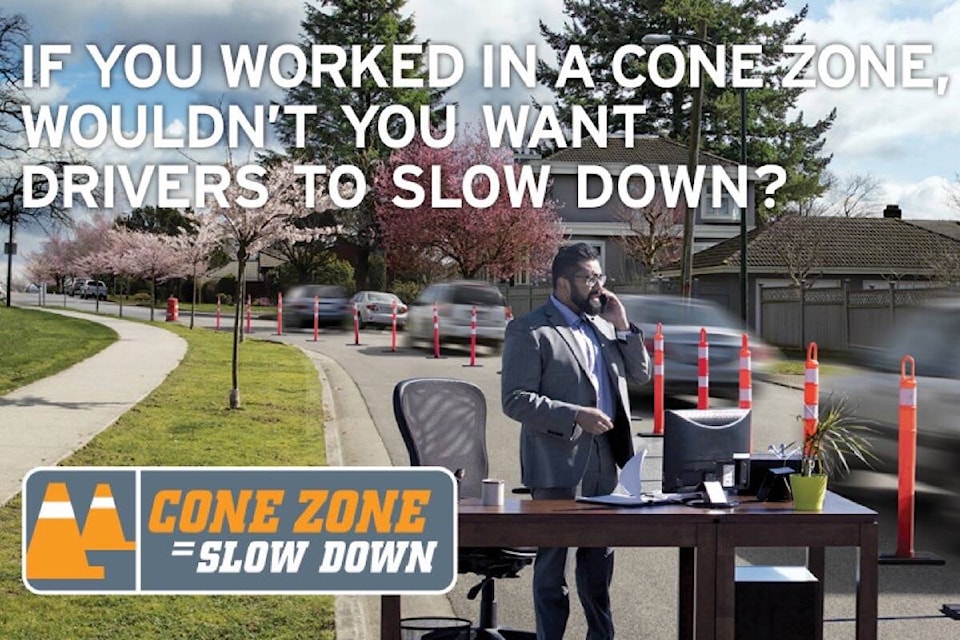Major work has started on the Coquihalla to restore the highway after last November’s flooding, and seasonal road work is ongoing throughout the province. That’s why drivers who are hitting the road this summer are asked to respect the Cone Zone, and the roadside workers who do their jobs while traffic flows around them.
During every shift they face the risk of being injured or killed. More vehicles are on the road during the summer, which increases that risk.
“Working around traffic is dangerous,” says Trace Acres, spokesperson for the annual Cone Zone safety awareness campaign. “Cone Zones are there to protect and save lives.”
Tens of thousands of British Columbians work at the roadside in Cone Zones, which are most often associated with bright orange cones. (Reflectors and other signs can also be used.) Each zone has its own unique set of hazards associated with roads, traffic, vehicles, weather, and work activities.
“Driving too fast and not paying attention in a Cone Zone puts roadside workers at risk,” Acres says. “Orange cones are often the only thing separating their workspace from your vehicle.”
Distracted driving has taken over from speeding as the number one hazard that could lead to someone being injured in a construction zone. Drivers slow down, then take the opportunity to look at their smartphones, which leads to a higher risk of accidents.
WorkSafeBC statistics show that two roadside workers in the province were killed last year, and 31 were injured seriously enough to miss work after being hit by a vehicle. Over the last decade, 12 roadside workers lost their lives and 221 missed time from work due to injury.
“It’s more than road construction and maintenance crews, and traffic control persons,” says Acres. “We’re also talking about landscapers, municipal workers, tow truck operators, utility workers, movers, and delivery van drivers. Also watch for flashing lights, and slow down when you see emergency and enforcement personnel.”
Traffic control people (flaggers) are often considered most at risk, because their role may include physically stopping and interacting with traffic, so they are the people drivers take their aggression out on when they are upset or anxious because of road construction. Behaviours witnessed in the work zone when drivers are enraged include excessive speeding on the approach to the work zone; tailgating other vehicles driving at adequate speeds; honking the horn; intentionally knocking or running over traffic control signs; rude gestures; revving engines; weaving in the traffic lineup to see ahead in the work zone; and driving on the shoulder.
Tow truck drivers are also especially vulnerable, as they often work alone at the roadside with sometimes as little as a flashing amber light and a hi-visibility vest to get the attention of motorists. Their work often requires that their attention be away from oncoming traffic, and they are often bending over or stooping or kneeling low to the ground, sometimes in positions without an escape route.
The annual Cone Zone campaign aims to raise awareness about the safety risk, and reminds employers, workers, and drivers to each do their part to prevent deaths and injuries. Drivers approaching a Cone Zone need to:
- Slow down and avoid distractions like a phone. A distraction of even a few seconds can have life-changing consequences.
- Pay attention to temporary road signs, traffic cones, and directions given by a traffic control person.
- Comply with BC’s Slow Down, Move Over law, which requires drivers to slow down and move over to the left lane when safe to do so for any vehicle flashing a red, blue, or amber light. This includes tow trucks, utility vehicles, garbage trucks, and emergency vehicles.
Typical penalties for unsafe driving in a Cone Zone include a $368 fine for using a phone and at least $196 for speeding.
Drivers can prepare themselves for encountering construction zones by planning for an extra 20 to 30 minutes of travel time; checking www.drivebc.ca for a list of road conditions and events; delaying their departure time or using a different route; and by being patient, especially at big jobs where you have to drive slowly for several kilometres.
“Every roadside worker deserves to make it home to their family at the end of their shift without injury,” says Acres.
editorial@accjournal.ca
Like us on Facebook and follow us on Twitter
